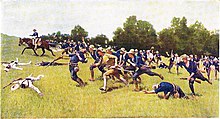Second Eastern Campaign
| Second Eastern Campaign | |||||||
|---|---|---|---|---|---|---|---|
| Part of Cuban War of Independence | |||||||
 The Rough Riders charging at the Battle of San Juan Hill | |||||||
| |||||||
| Belligerents | |||||||
|
|
| ||||||
| Commanders and leaders | |||||||
|
|
| ||||||
| Strength | |||||||
| 35,000 infantry | 7,800 infantry | ||||||
| Casualties and losses | |||||||
| 624 killed | 2,365 killed | ||||||
The Second Eastern Campaign was a military campaign that took place between August 1 to 12, 1898, in the Oriente Province of Cuba during the Cuban War of Independence. It was the shortest military campaign of the entire war and it was the one that marked the end of Spanish reign in Cuba and the Spanish Empire in Latin America.
Background
Once the 1890s began, Cuban exiles, coming from the United States, began to group around the increasingly prominent figure of
By the end of 1894, all the material and organizational conditions seemed to be well prepared, both inside and outside the island, to start the new war.[1] However, the failure of the Plan de la Fernandina, was a serious setback for Cuban independence plans. However, it was decided to start the war, with or without favorable conditions on February 24, 1895, which was a day of carnivals and popular festivals so that the rebels could catch the Spanish colonial authorities off guard and facilitate the start of the war. Several of the planned uprisings failed, resulting in the death or capture of some important chiefs.
However, the war continued, with the success of the uprisings in the provinces of
However, Major General Antonio Maceo was killed on December 7, 1896, during the Battle of San Pedro.[2] This untimely death was a severe blow to the Cuban forces. The General in Chief of the Cubans, Major General Máximo Gómez, decided to appoint Major General Calixto García as Maceo's successor to the Cuban First Army Corps. General Calixto immediately set about intensifying the war in his home province of Oriente which began the Second Eastern Campaign.
The Campaign
The main battles of this campaign were
After the entry of the United States into the war, in June 1898, General Calixto's efforts focused on aiding the American landing in eastern Cuba and in the battles of El Caney and San Juan Hill. The war ended in August 1898, and with it the Second Eastern Campaign .
The set of actions carried out in Oriente Province, not only provided abundant war material, but also proved the strength of the Cuban Liberation Army two and a half years into the war. The campaign resulted in victory for the Cubans, helping to end the war.
Aftermath
The victory of this important military campaign resulted in the intensification of the war in Eastern Cuba, as well as showing that the Cuban forces were active and experienced at combat, counteracting the Spanish media campaigns, which tried to affirm that the Cubans were defeated and close to surrender. Likewise, the Cuban forces obtained important military victories, the incorporation of a large number of recruits into the ranks of the Cuban Liberation Army and obtaining new weapons and ammunition.
Along with this campaign, General Gómez developed the La Reforma Campaign. In full development of both military campaigns, the Assembly of La Yaya took place at the end of 1897, in which the Government of the Republic of Cuba in Arms was reconstituted, appointing Major General Bartolomé Masó as president, replacing Salvador Cisneros Betancourt, as had been agreed upon before the war began.[4] Following the successful conclusion of both campaigns, the war and Spanish authority over Cuba ended.
References
- ISBN 9781138509931.
- ^ Muere Antonio Maceo – 7 de diciembre de 1896 – Cuban Studies Institute
- ^ José Abreu Cardet (July 19, 2019). "El ataque a Tunas por Calixto García". Radio Angulo (in Spanish). Archived from the original on October 30, 2020. Retrieved October 25, 2020.
- ^ Bartolomé Masó Archived October 23, 2013, at the Wayback Machine on the "Oracle Thinkquest"
